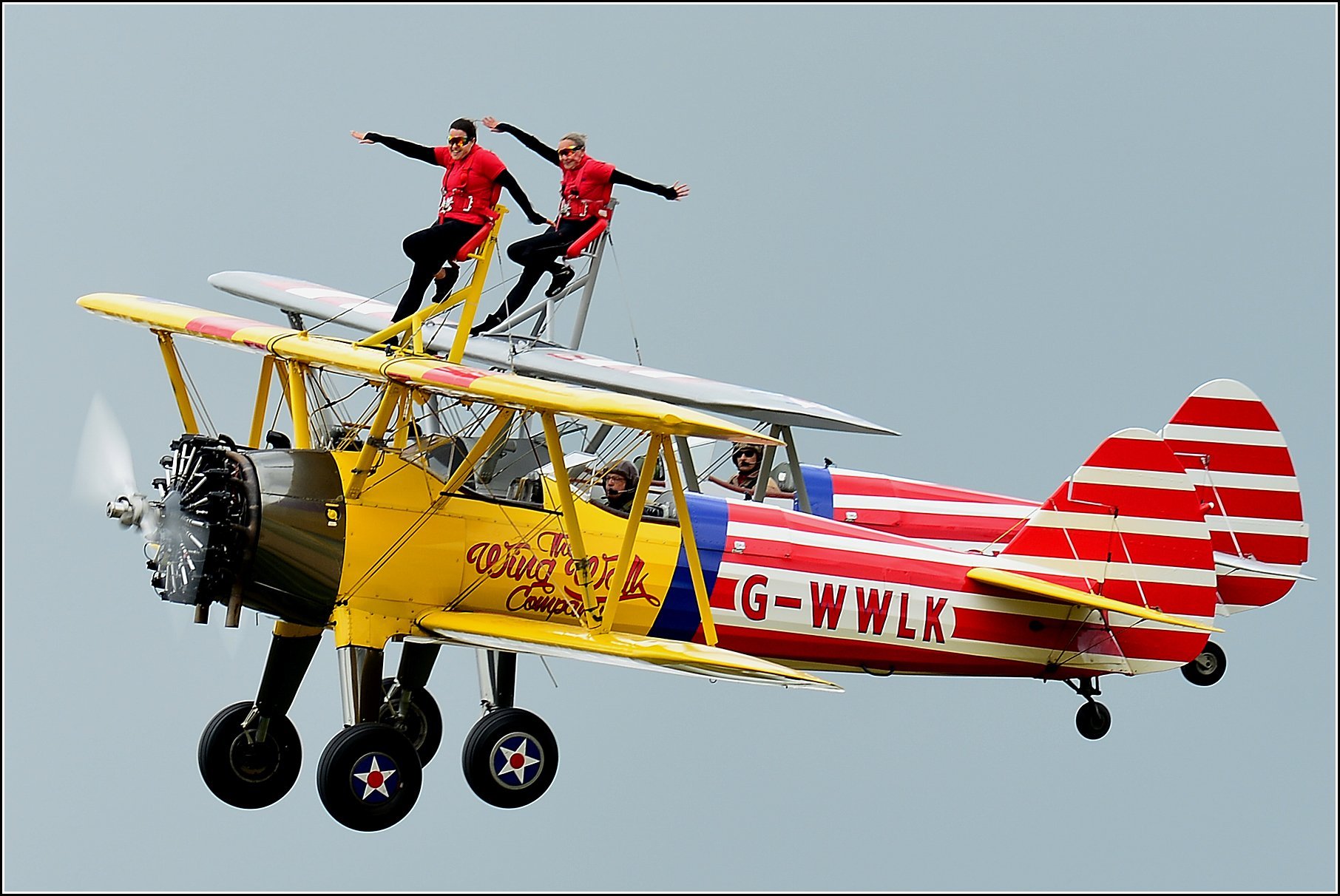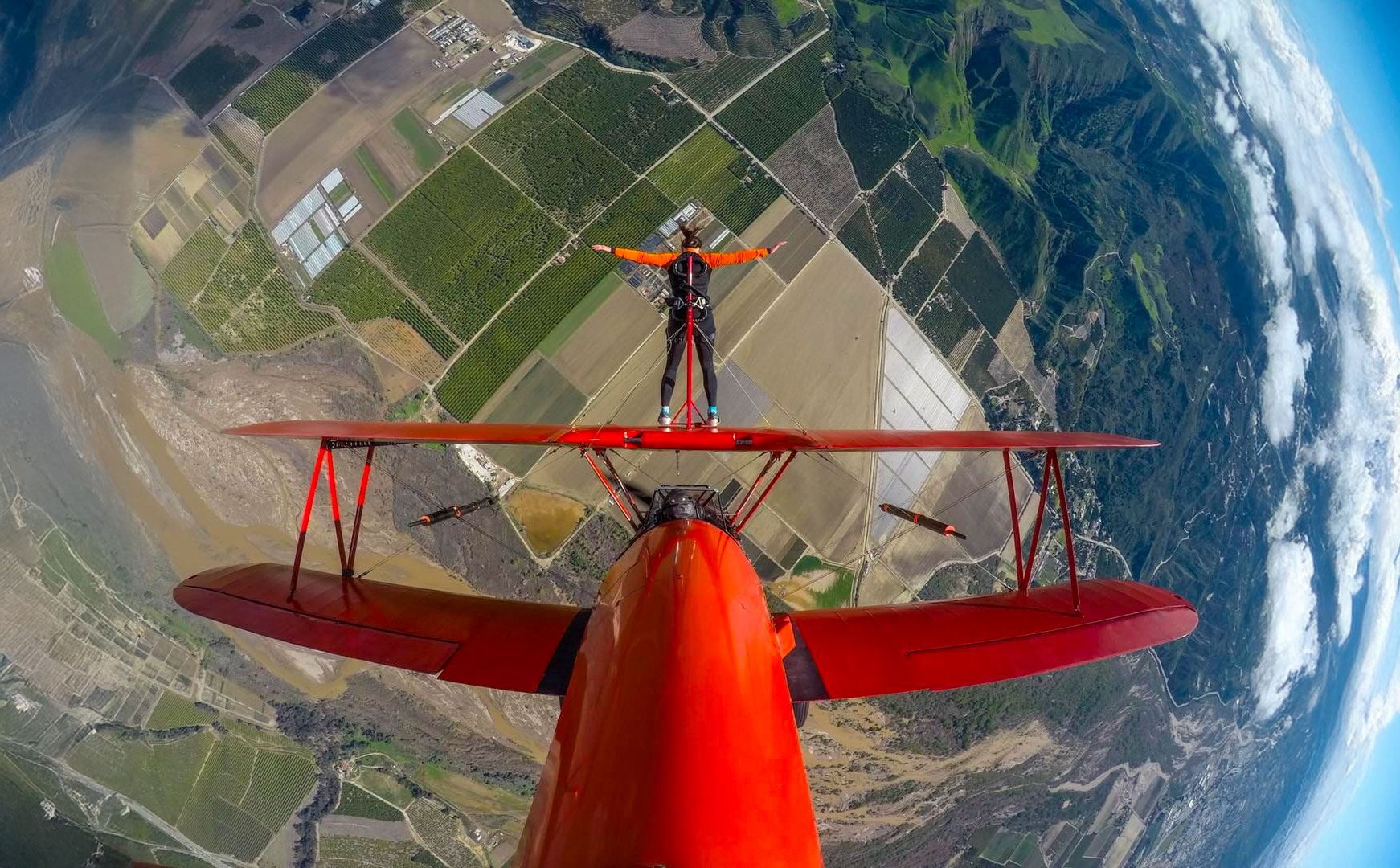Para aqueles que anseiam por aventuras fora do comum, onde o céu não é o limite, mas sim o parque de diversões, o wing walking surge como uma experiência sem igual. Imagine-se a voar pelos ares, com o vento a passar, sem nada mais do que um arnês a ligá-lo à asa de um biplano antigo. Não se trata apenas de uma emoção; é uma viagem pela história da aviação, uma montanha-russa de emoções e uma oportunidade de se juntar a um clube exclusivo de aventureiros que voam alto.
Uma história emocionante nos céus
A história do wing walking é tão cativante como o próprio ato, com as suas raízes a remontarem aos dias pioneiros da aviação. O primeiro caso documentado de alguém que se aventurou fora do cockpit durante um voo ocorreu em Inglaterra, a 14 de janeiro de 1911. Neste voo experimental, o Coronel Samuel Franklin Cody levou os seus dois enteados para o ar no seu biplano e, numa demonstração de ousadia dos primeiros tempos da aviação, eles ficaram na asa inferior. Este ato inicial, embora talvez não tenha sido uma proeza planeada, indiciava o fascínio humano por desafiar a gravidade e ultrapassar os limites do que era possível nestas máquinas voadoras nascentes. Apenas dois anos mais tarde, em agosto de 1913, um comandante francês chamado Felix levou esta ousadia um pouco mais longe. Enquanto pilotava o seu biplano "Nieuport-Dunne" sobre França, bloqueou os controlos e desceu para a asa inferior, permitindo que o avião voasse sozinho por momentos. Estes primeiros episódios ilustram uma curiosidade humana inerente e um espírito de aventura entrelaçados com o desenvolvimento do voo motorizado. O próprio ato de se colocar fora da estrutura aparentemente frágil destes primeiros aviões revela um desejo de se ligar à experiência de voar de uma forma visceral e sem precedentes.
No entanto, o aparecimento do "wing walking" como forma de entretenimento e busca de emoção é largamente creditado aos "barnstormers" da década de 1920 na América. Após o fim da Primeira Guerra Mundial, os Estados Unidos depararam-se com um excedente de pilotos militares treinados e uma abundância de aviões militares baratos. Estes pilotos, procurando utilizar as suas capacidades e ganhar a vida em tempo de paz, formaram o que ficou conhecido como "Circos Voadores". Viajaram por toda a América, muitas vezes utilizando os campos dos agricultores como aeródromos improvisados - daí o nome "barnstormers" - oferecendo viagens de passageiros e realizando espectáculos aéreos para o público. Estes espectáculos foram a primeira experiência real do público com a aviação e, para atrair multidões, os pilotos começaram a incorporar acrobacias cada vez mais ousadas nas suas actuações. Acrobacias aéreas como loops, rolls e spins tornaram-se comuns, mostrando o domínio dos pilotos sobre as suas máquinas. À medida que a sua confiança crescia, alimentada por um espírito competitivo, as acrobacias aumentavam em perigo e audácia.

Foi neste ambiente de exibições ousadas que o wing walking se tornou um verdadeiro espetáculo. O americano Ormer Locklear é amplamente reconhecido como um dos primeiros e mais audaciosos "wing walkers", tendo feito a primeira apresentação pública das suas acrobacias que desafiavam a gravidade em Barron Field, Texas, em novembro de 1918. Para estes primeiros artistas aéreos, o wing walking era considerado uma forma extrema de barnstorming, e muitas vezes admitiam abertamente que o seu objetivo era ganhar dinheiro arriscando as suas vidas para entretenimento do público. Esta era assistiu ao aparecimento de muitos aerialistas populares, incluindo nomes como Tiny Broderick, Gladys Ingle e até Charles Lindbergh, que começou a sua carreira na aviação como um wing walker. Estes artistas procuravam constantemente superar-se uns aos outros, ultrapassando os limites do que podia ser feito nas asas de um biplano. As acrobacias evoluíram e passaram a incluir pausas de mão efectuadas a centenas de metros de altura, pendurados precariamente pelos dentes e até a transferência, de cortar a respiração, entre dois aviões em pleno voo. As multidões eram cativadas por estas actuações arriscadas, que eram frequentemente captadas em filme, alimentando ainda mais o fascínio do público. Como prova do engenho da época, um artigo de 1931 propunha mesmo uma aplicação prática para o wing walking em aviões invertidos: a inspeção ou manutenção do trem de aterragem em voo. Os "wing walkers" também começaram a incorporar transferências entre o avião e vários veículos terrestres, como carros, barcos ou comboios, acrescentando outra camada de complexidade e perigo aos seus actos. Algumas variações incluíam mesmo quedas livres da asa, com um para-quedas a abrir no último momento. No entanto, a era de liberdade do barnstorming, com os seus perigos inerentes, começou a diminuir. Em meados da década de 1920, o aumento das normas de segurança, motivado por numerosos acidentes, começou a pôr termo a este período. O crash da bolsa de 1929 contribuiu ainda mais para o desaparecimento de muitos circos voadores proeminentes. Em 1936, o governo americano pôs efetivamente fim a esta prática nos Estados Unidos, proibindo os circos voadores abaixo dos 460 m (1.500 pés) devido a problemas de visibilidade para o público. Apesar deste declínio, o fascínio do wing walking nunca desapareceu completamente. Na década de 1970, a atividade voltou a renascer, mas com uma ênfase muito maior na segurança. Foram impostas restrições, como a exigência de os artistas estarem presos à secção central superior da asa. Atualmente, os profissionais modernos de "wing walkers" actuam presos a estruturas metálicas especializadas que estão firmemente ligadas às asas do avião. Esta abordagem moderna torna a experiência emocionante, atenuando significativamente os perigos dos primeiros tempos. Atualmente, o wing walking continua a ser praticado por vários indivíduos e equipas, muitas vezes como parte de espectáculos aéreos e oferecendo ao público a oportunidade de experimentar esta aventura aérea única.
Abrace a experiência inesquecível: O que o espera na asa
Subir para a asa de um biplano para uma experiência de wing walking é envolver-se numa tradição que mistura a ousadia histórica com a segurança moderna. Ao contrário dos primeiros barnstormers, que muitas vezes contavam apenas com a sua garra e coragem, o wing walking atual é uma aventura cuidadosamente orquestrada, concebida para maximizar a emoção, dando prioridade ao bem-estar dos participantes. Os wing walkers profissionais modernos são fixados ao avião utilizando estruturas metálicas especialmente concebidas e arneses de cinco pontos, assegurando uma experiência segura mas emocionante. Antes mesmo de subir aos céus, será submetido a uma formação exaustiva, que inclui frequentemente sessões de treino em terra. Estas sessões são cruciais para construir a memória muscular necessária para a subida inicial do cockpit para a sua posição na asa. Esta subida envolve uma série de degraus e apoios de mão específicos, cuidadosamente concebidos para lhe permitir deslocar-se com segurança e confiança para a asa. Aprenderá a navegar na estrutura do avião e a fixar-se ao equipamento de marcha da asa, tudo sob a orientação de profissionais experientes. Esta ênfase numa formação abrangente e em protocolos de segurança rigorosos visa minimizar quaisquer riscos potenciais, permitindo-lhe mergulhar totalmente na incrível experiência que o espera.
Assim que o biplano levantar voo, será imediatamente confrontado com a força bruta da natureza. Prepara-te para ficar espantado com a força do vento, que pode ser ainda mais forte do que poderias prever. A velocidades que podem atingir os 140 mph, a corrida do ar contra o teu corpo é parte integrante da sensação de andar de asa. O poderoso rugido do motor do avião será uma lembrança constante da incrível máquina que o transporta pelos céus. Dependendo do tipo de voo que escolher, poderá até experimentar momentos de ausência de peso durante certas manobras, como mergulhos efectuados pelo piloto experiente. No meio destas sensações físicas intensas, o ar em si é extraordinariamente fresco e revigorante, um forte contraste com o ar reciclado de um avião comercial. Esta combinação de vento, velocidade e ar livre cria um encontro sensorial que é verdadeiramente único e inesquecível, envolvendo todos os seus sentidos de uma forma que poucas outras experiências conseguem igualar.
Para além das sensações físicas, andar de asa é uma viagem emocional que abrange um vasto espetro de sentimentos. É natural sentir uma sensação de antecipação, talvez até mesmo um toque de apreensão, antes de levantar voo. Muitos dos que andam pela primeira vez nas asas contam um momento de "Porque é que estou a fazer isto?" enquanto o avião se prepara para descolar. No entanto, estes nervos iniciais rapidamente dão lugar a uma adrenalina avassaladora e a um sentimento de euforia quando se está no ar. A sensação de liberdade é profunda, sendo muitas vezes descrita como a sensação de um pássaro a voar no céu. Para muitos, a experiência consiste em confrontar e vencer um medo, ultrapassar os limites pessoais e provar a si próprios que são capazes de alcançar algo extraordinário. São comuns os momentos de puro espanto e admiração com as vistas de cortar a respiração, bem como a profunda sensação de estar verdadeiramente vivo e ligado ao mundo de uma forma única. Em última análise, o sentimento de realização e orgulho que se apodera de si depois de completar uma caminhada nas asas é significativo e duradouro. Um dos aspectos mais notáveis da caminhada nas asas é a perspetiva sem paralelo que oferece. Do seu ponto de vista sobre a asa, testemunhará a beleza da terra de um ângulo que poucos conseguem ver. Terá a oportunidade de apreciar vistas deslumbrantes da paisagem circundante, que se estende por baixo de si como uma manta de retalhos. Muitos caminhantes descrevem a sensação de estar no topo do mundo, com uma vista ampla e desobstruída que proporciona uma apreciação completamente diferente da paisagem. Quer esteja a sobrevoar colinas ondulantes, linhas costeiras pitorescas ou aeródromos encantadores, as vistas a partir da asa são garantidamente memoráveis e inspiradoras. Esta perspetiva única, combinada com as sensações estimulantes do voo, faz com que andar de asa seja uma experiência que ficará consigo muito tempo depois de ter regressado a terra firme.
Pronto para voar? O seu guia para reservar a sua experiência de Wing Walking
Se a ideia de se colocar na asa de um biplano despertou o seu sentido de aventura, dar o salto e reservar a sua própria experiência de andar na asa é mais acessível do que possa pensar. Várias empresas de renome oferecem a oportunidade de participar nesta atividade extraordinária, cada uma com as suas próprias ofertas e locais únicos.
No Reino Unido, A empresa Wing Walk destaca-se como um fornecedor proeminente, operando a partir de quatro locais em todo o país: Headcorn, em Kent, Henstridge, em Somerset, Wickenby, em Lincolnshire, e Sywell, em Northamptonshire. Com uma história que remonta a 1984, são reconhecidos como a única equipa de formação de asas ambulantes do mundo, acrescentando uma camada extra de experiência e espetáculo às suas operações. Outro fornecedor líder no Reino Unido é Fazer Wingwalkingque voa a partir de um aeródromo privado em Cotswolds, Gloucestershire, e também a partir de Sywell, em Northamptonshire. Fazem parte da AeroSuperBatics Ltd, uma empresa com mais de 40 anos de experiência em acrobacias aéreas e exibições de wing walking, garantindo um elevado nível de profissionalismo e emoção. Do outro lado do Atlântico, nos Estados Unidos, o Academia Mason Wing Walkinglocalizada em Sequim, Washington, reivindica a distinção única de ser a única escola de wing walking no mundo que oferece formação que permite aos participantes saírem efetivamente do cockpit e movimentarem-se nas asas durante o voo.
O processo de reserva para a maior parte das experiências de caminhada nas asas envolve normalmente a verificação dos locais e datas disponíveis, a garantia de que cumpre os pré-requisitos necessários e, em seguida, a reserva do voo online ou por telefone. Os pré-requisitos geralmente incluem ter pelo menos 18 anos de idade (algumas empresas têm um limite de idade superior, mas outras não), cumprir as restrições específicas de altura e peso (por exemplo, uma altura máxima de 1,80 m e um peso máximo de cerca de 14 quilos são comuns) e ser capaz de subir para a asa do biplano sem ajuda. É importante notar que certas condições médicas, tais como epilepsia, tensão arterial elevada e problemas cardíacos, podem impedir a participação por razões de segurança. Antes do voo, é-lhe pedido que assista a um briefing de segurança completo e que assine uma declaração de aptidão física.
Os tipos específicos de experiências de wingwalking oferecidos podem variar. A Go Wingwalking, por exemplo, oferece opções para um Wingwalk pela primeira vez, uma experiência acrobática mais aventureira e até um Wingwalk de formação de cortar a respiração para duas pessoas. A The Wing Walk Company oferece uma Experiência Wing Walk normal, uma Experiência Wing Walking de Formação para pares e Experiências de Eventos de Caridade para fins de angariação de fundos. Algumas empresas, como a Go Wingwalking, podem oferecer acrobacias aéreas para aqueles que já completaram um primeiro passeio de asa. Por outro lado, a Mason Wing Walking Academy, nos EUA, concentra-se num curso mais aprofundado, de um dia inteiro, que ensina aos participantes as competências necessárias para subir nas asas superiores e inferiores do avião, fazendo uma distinção entre "wing walking" (deslocação) e "wing riding" (estar preso numa posição fixa). O custo de uma experiência de "wing walking" varia naturalmente consoante o local, a duração do voo e o tipo específico de experiência escolhido. No Reino Unido, pode geralmente esperar pagar entre £399 e £450 por uma experiência normal de "wing walking". Alguns fornecedores podem oferecer preços ligeiramente reduzidos para reservas durante a semana. Para aqueles que procuram a emoção adicional das acrobacias aéreas, o custo pode rondar as £495, enquanto os passeios de asa em formação para dois serão naturalmente um investimento mais significativo. Nos Estados Unidos, o curso completo de dia inteiro na Mason Wing Walking Academy custa normalmente cerca de $1250, com uma opção de meio dia disponível por aproximadamente $850. É importante notar que estes preços incluem frequentemente o treino, bem como fotografias e vídeos da sua incrível proeza.

Conclusão
O fascínio do wing walking, com a sua história rica e a promessa de uma adrenalina sem paralelo, continua a cativar aqueles que procuram experiências extraordinárias. Quer seja atraído pelo romantismo dos primeiros tempos da aviação, pelo desejo de ultrapassar os seus limites pessoais ou simplesmente pela procura de uma aventura inesquecível, o wing walking oferece uma oportunidade única de sentir o vento sob as suas asas no sentido mais literal. Com medidas de segurança modernas e profissionais experientes a guiar todos os seus passos, esta acrobacia outrora ousada é agora uma emoção acessível para os corajosos o suficiente para subir aos céus. Por isso, se está pronto para elevar as suas aventuras a novas alturas e criar memórias que durarão para toda a vida, talvez seja altura de reservar a sua própria experiência de andar nas asas e descobrir a emoção que o espera nas asas.

